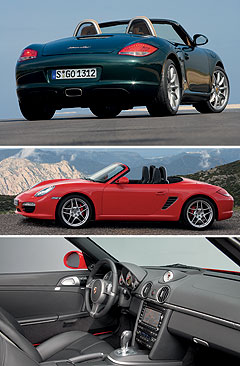New models - Porsche - Boxster - rangeFirst drive: Porsche Boxster comes out punchingTop down: The new Porsche Boxster prices start at $113,000. Inflation-busting Boxster arrives with new engines and seven-speed PDK transmission17 Mar 2009 PORSCHE’S Boxster is a great example of how the changing face of the Australian motor industry has resulted in a buyer’s market for premium imports, with the more powerful and better-equipped model released this week at $113,000 – just $3100 more than the original Boxster when it was launched in January 1997. That is an increase of just 2.8 per cent in more than a decade, despite the introduction of the luxury car tax (LCT). Compared with 12 years ago, buyers of the base model Boxster now get a six-speed manual and a 2.9-litre engine developing 188kW of power and 290Nm of torque instead of the original car’s 150kW/245Nm 2.5-litre flat-six and five-speed gearbox. And in 1997 you were lucky to get ABS, climate control and a CD player, whereas today you get things like ESC, multiple airbags, touchscreen infotainment with iPod connectivity, parking sensors, heated seats, a glass window, a wind deflector, better performance (a full second faster from 0-100km/h) and 8.2 per cent better fuel economy. On specification alone, Porsche says the Boxster now carries between $10,000 and $12,000 more equipment.  Some of those features were still options only last month, so has there ever been a better time to buy any new car, let alone a Porsche? We say, to hell with the LCT. Some of those features were still options only last month, so has there ever been a better time to buy any new car, let alone a Porsche? We say, to hell with the LCT.The facelifted Boxster – which is a mid-life refresh of the second-generation 987-series – arrives here as a two-model line-up again, with the Boxster S now priced at $140,400, which is $700 more than the superseded model. Its bigger 3.4-litre engine gains direct fuel injection (while the base model retains normal injection for cost reasons) and produces 228kW (up 10.7 per cent on the previous 206kW 3.2-litre unit in the S) and 360Nm (up some 40Nm, or 12.5 per cent), but is 11.5 per cent more fuel efficient and, of course, cleaner as well. Both of the new units are from the same engine family introduced last year to the 911 range and are totally new, with a lower centre of gravity to assist handling and virtually no shared parts with the previous-generation engines. In fact, the new engine family is Porsche’s first since it went to water cooling in the 1990s. There is also plenty of interest from a technical perspective in the availability of Porsche’s new PDK twin-clutch manumatic gearbox, which also debuted only late last year in the 911 range. The seven-speed PDK (with two overdrive gears) replaces the five-speed Tiptronic S as the Boxster’s automatic option and costs $5500, which is about $600 more. PDK not only changes 60 per cent faster than Tiptronic S, but is 10kg lighter and saves an estimated 16 per cent in fuel consumption, but operates the same, with steering wheel paddles and a gear indicator on the instrument binnacle. Among the extensive Boxster options list are a ceramic/carbon brake package at some $19,980, an electronic suspension system called PASM ($4190) and, for the first time, a limited slip differential ($2990). While the 2009 Boxster is mainly about the mechanicals, the company says the nose and tail have both been subtly reshaped, with two-tube headlights, larger front intakes, tapering LED tail-lights and diffusers.
Read more:LA show: Mid-life makeover for Boxster and CaymanBoxster pricing
Motor industry news |
|
||||||||||














Facebook Twitter Instagram